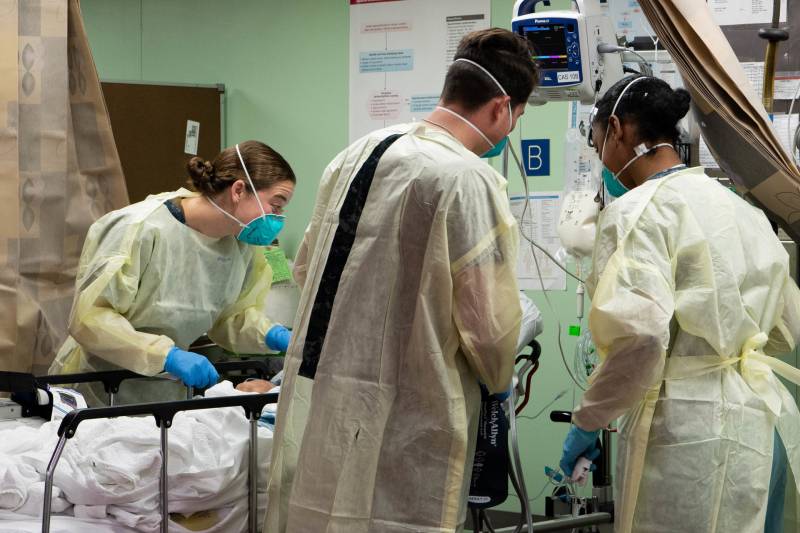“The more reliable numbers, aside from the number of deaths, are how many people get sick enough to be in the hospital and in the ICU,” he said. “That’s what we need to know.”
If epidemiologists have a clear hospitalization rate, they can predict how many people may eventually die from this coronavirus and estimate how many beds a hospital system will need as the virus spreads.
“So as long as people aren’t being turned away, we must focus on hospitalizations and ICU cases,” Goodman said.
Under pressure from public health experts and the media, the state has begun releasing some overall numbers on the number of patients admitted to hospitals with COVID-19. As of Tuesday, the California Department of Public Health said the statewide count stood at 1,617 hospitalizations for the disease, including 657 patients being treated in ICUs.
The state says another 3,400 patients have been admitted with suspected COVID-19 symptoms, with 600 or so in that group also in ICUs.
Newsom began mentioning specific hospitalization numbers last weekend. But that was well after other jurisdictions experiencing major outbreaks, like New York City, Louisiana and Florida began posting detailed data on testing and hospitalizations.
Although the Bay Area has led the nation in adopting aggressive social distancing measures, detailed information on hospitalizations in the region is relatively scarce:
-
- Alameda County: Does not report hospitalizations related to COVID-19.
- Contra Costa County: 23 hospitalizations related to COVID-19 as of March 30.
-
- Marin County: 14 hospitalizations related to COVID-19 as of March 30.
- Napa County: Does not report hospitalizations related to COVID-19.
- San Mateo County: Does not report hospitalizations related to COVID-19.
- Santa Clara County: 152 hospitalizations as of March 31.
- San Francisco County: 58 hospitalizations related to COVID-19 as of March 30.
- Sonoma County: 17 hospitalizations related to COVID-19 as of March 31.
- Solano County:13 hospitalizations related to COVID-19 as of March 31.
A Call for More and Better Data
Public health experts and reporters are calling for more transparency around the state’s coronavirus data.
In a response to a reporter’s question Monday about why the state health department is not providing county hospitalization totals, Newsom said: “We will provide that information. We will make sure you get it.”
Some places will report the latest hospital numbers when it’s requested, including San Francisco and Contra Costa counties. Other jurisdictions have begun to push their data through online dashboards, including Sonoma, Marin and Solano counties.
While some counties have released data, it’s not enough to paint a clear picture of what is happening at hospitals around the Bay Area.
Making the picture harder to interpret, some counties, like Solano a report their total number of hospitalizations over the course of the pandemic, while Contra Costa and other counties track the daily total. Other places aren’t reporting hospitalizations at all.
“We don’t have the capacity to extract information and provide to the media or the public,” said Preston Merchant, public information officer with San Mateo County.
Santa Clara, the hardest hit county in the Bay Area, was posting daily public hospitalization numbers, but stopped doing that last week after introducing a streamlined data dashboard.
County health officials said in an emailed statement that they “know the public is interested in receiving up-to-date information regarding hospital utilization and capacity in anticipation for the surge in COVID-19 cases. We are working to provide that information as quickly as possible. We plan to release additional elements of our data dashboard in the coming days.”
In contrast to Bay Area counties, Southern California jurisdictions have been posting daily updates on the number of people hospitalized with COVID-19. On Tuesday, for instance, Los Angeles County reported a total of 594 hospitalizations to date — up from 160 on March 25.
Similarly, San Diego, Orange, Ventura and Santa Barbara counties are all posting patient numbers.
Some health care providers say they won’t provide data on the number of COVID-19 hospitalizations they’re seeing, citing patient privacy laws.
Sutter Health spokeswoman Angie Sheets said the company cannot release such data “out of respect for patient and employee privacy.”
“Even in times of emergency, HIPAA (a federal health care law) still applies, and it is our duty to protect patient, staff and clinician privacy,” she said.
Kaiser Permanente, which operates more Northern California’s biggest hospital network, also declined to report its coronavirus patient numbers.
But according to internal Kaiser information obtained by NPR, as of Monday evening, 184 coronavirus patients were hospitalized in Kaiser’s Northern California hospitals. Sixty-three of those patients are in Kaiser ICUs.
Not all hospitals are declining to disclose their numbers.
Zuckerberg San Francisco General Hospital reports 15 patients with the virus.
At UCSF, Dr. Bob Wachter, chair of the school’s department of medicine, has been tweeting out the number of patients in that hospital system each day. As of Monday, it was 14.

